Friendship Cities Conference and Friendship Forum |
A fourteen-member delegation led by USCPFA Robert Sanborn met in Shanghai for the China International Friendship Cities Conference, hosted by Youxie (Chinese People’s Association for Friendship with Foreign Countries or CPAFFC). The delegation, selected by application, was composed of members of USCPFA at chapter, region and national levels. From September 7-17, 2010, the delegation participated in meetings, discussions, panels, and friendly discourse over many delicious meals and also toured the northern part of Jiangxi Province, the cradle of Chinese revolution. The ten days included taking part in the Friendship (Sister) Cities Conference in Shanghai from September 7-10, flying to Nanchang, capital of Jiangxi Province for the Fourth Friendship Forum on September 11, and touring Jiangxi Province from September 12-16, 2010.
Text by USCPFA Secretary, Diana Greer - Richmond
Photos by Linda Hanley, Kansas City Chapter
|
Friendship (Sister) Cities Conference |
With the theme “Better Cities through Cooperation,” the China International Friendship Cities Association (CIFCA) convened at the Shanghai International Convention Center on September 8. Madame Li Xiaolin, Vice President of the CPAFFC which co-sponsored the conference with CIFCA, presided over the opening ceremony beginning with remarks by Chen Haosu, President of CPAFFC. Among those who gave brief opening remarks was The Honorable Jimmy Carter, former President of the United States.
at right: Jimmy Carter giving remarks at the Opening Ceremony of the Friendship Cities
Conference in Shanghai
2010 China International Friendship Cities Conference |
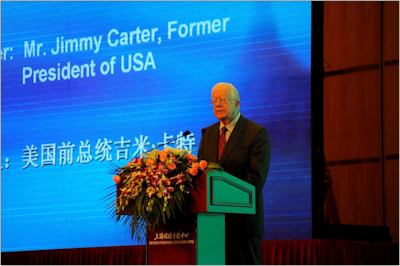 |
|
Many weeks before the Friendship Forum, the U.S. delegation members realized that Jimmy Carter would be in Shanghai as a guest speaker at the conference. Officials at The Carter Library encouraged USCPFA national board members to go forward with award plans to honor Mr. Carter in Shanghai. On the morning of September 8 at the Shanghai Conference Center, the USCPFA delegation was whisked away in a van to an undisclosed location for security reasons. There USCPFA President Robert Sanborn, on behalf of all USCPFA members, presented Mr. Carter with an engraved USCPFA medallion and a special certificate in recognition of his extraordinary achievements in U.S.-China relations. Mr. John Hardman, CEO and President of The Carter Center, witnessed the occasion, as did Madame Li Xiaolin, who also presented a beautiful work of art created by the Chinese people to Mr. Carter and The Carter Library. At right is Former President Jimmy Carter and USCPFA President Robert Sanborn. |
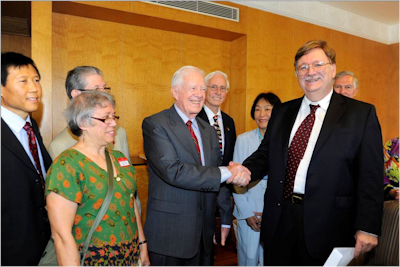 |
|
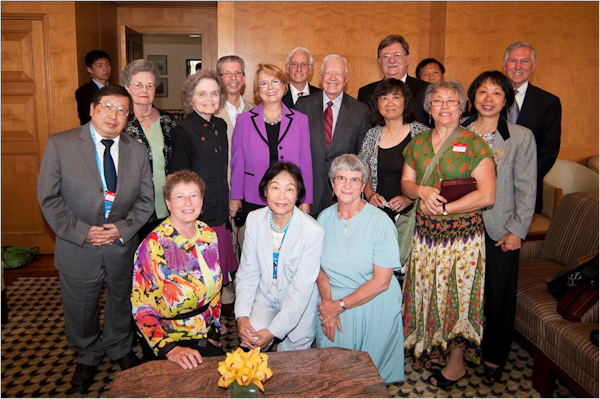 |
USCPFA delegation with The Honorable Jimmy Carter, Former President of the
United States and John Hardman, President of The Carter Center
(front row kneeling) Mary Warpeha, Elena Lu, Linda Hanley
(middle row) Joe Lau, Rose Mary Thompson, Mary Ruth O'Connell, Jimmy Carter,
Mimi Lau, Diana Greer,Suzanna Lin
(back row) Joyce Cox, Stanley Yon, Daniel O'Connell, Robert Sanborn, Edward
Lin, John Hardman |
|
The USCPFA thanked Mme. Li Xiaolin, Vice President of CPAFFC and CEO John Hardman of The Carter Center for making it possible to meet and honor Mr. Carter in Shanghai. With assistance of members of the USCPFA Atlanta Chapter, Tour Coordinator Barbara Cobb, and others, USCPFA finally was able to honor Mr. Carter for his untiring efforts in building friendships between the People’s Republic of China and the United States. On meeting Mr. Carter, one is reminded of how humble and gracious he is and how deeply he has endeared himself to so many people, and especially to the people of China and the United States. This was quite an auspicious occasion for all and one that those present will never forget. |
The USCPFA delegation rejoined the conference to hear speeches on important topics including the impact of the global financial crisis, energy conservation, emission reduction, new energy resources, and urban environmental protection. Speakers discussed urban infrastructure relating to public transport and cultural and sports facilities, as well as new city brand building. That afternoon Mr. Li Jianping, Vice President of CPAFFC presided over the Signing Ceremony for Newly-Twinned Friendship Cities. Those cities included Xi’an, Shaanxi Province & Cuenca City, Ecuador; Jinzhong, Shanxi Province & Hoi An City, Vietnam; Jincheng, Shanxi Province & Cacadu District, South Africa and Jiading District, Shanghai & Hauraki, New Zealand. After a formal welcoming dinner hosted by CPAFFC and CIFCA, the delegations were invited to take a cruise tour for a night viewing on the Huangpu River. This proved to be a memorable day for the USCPFA delegation members and the trip had just started!
On September 9, delegations left at seven o’clock in the morning to board buses to go to the Shanghai Expo. Poised high in the sky like a regal red abstract pagoda, the China Pavilion was a breathtaking sight with its unusual trapezoid design. Our hosts took us straight into the building without any waiting. The section titled “National Treasures” exhibited an amazing 130-meter wall of people, animals, water and things moving digitally on a recreated ancient landscape painting called “Riverside Scene at Qingming Festival” by artist Zhang Zeduan of the Song Dynasty. It was unbelievably beautiful and enchanting with its pulsating movement of people, flickering lanterns and rippling waters. |
Heading back to the convention center, smaller groups attended separate regional friendship cities sessions, divided into four regions. The four regions included China and the U.S., Russia, Africa, and Latin American/Caribbean. Mary Warpeha, Co-President of the Minnesota Chapter, gave an excellent PowerPoint/lecture on People-to-People Exchanges and the Minnesota Chapter’s Role and Involvement over many years of developing friendship with the Chinese people. We learned much about what Minnesota is doing presently and also what they have accomplished since 1982, when they began formal sister-province relations with Shaanxi Province. Examples of planning and creating a Chinese garden to a Dragon Boat Festival to sessions on disaster response plus lectures, cultural exchanges and many other activities demonstrated how Minnesota Chapter is an extraordinary role model for other chapters, as well as a vital friendship bridge between the U. S. and China. Mrs. Warpeha’s presentation was very warmly received. After lunch, we returned to the Shanghai Expo to visit the U.S. Pavilion and an exhibition “Better Cities Through Cooperation” organized by CPAFFC and CIFCA. |
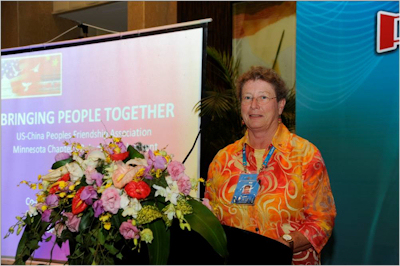 |
Mary Warpeha, Co-President of USCPFA Minnesota presents PowerPoint on
People-to-People Exchanges at Sister Cities Forum |
|
|
On September 10, during the closing ceremony for the Friendship Cities Conference, Mme. Li Xiaolin announced the winners of the Friendship Awards. Many awards were given to Friendship Sister Cities representatives in different categories, such as communication, cooperation with China and special contributions. Many celebratory speeches were given by representatives from all over the world with closing speeches by Mr. Tang Dengjie, Vice Mayor of Shanghai, Mr. Han Zheng, Mayor of Shanghai, Mr. Chen Haosu, President of CPAFFC.
The final speech was by Mme. Li Xiaolin, Vice President of the CPAFFC, who announced that the next Friendship Cities Conference would be in Chengdu in 2012. Between China and 125 countries, the new total of 1721 twinned friendship cities was flashed across the screen. The USCPFA delegation members thank CPAFFC, CIFCA and the Shanghai City leadership for hosting us. For some of us it was our very first Friendship Cities Conference; one never to be forgotten. Friendship Forum delegations departed for Hongqiao Airport for Nanchang, capital of Jiangxi Province for the second part of the journey. |
Fourth Friendship Forum - Nanchang |
The Fourth Friendship Forum took place in Nanchang, provincial capital of Jiangxi Province. Nanchang is a center for politics, science, culture and economics and is known for the Communist Party’s uprising in 1927, which led to the founding of its army.
Delegations invited on the tour of northern Jiangxi Province included Tonga, Australia, Canada, Vanuatu, New Zealand, Maori, United States, Guyana, Bahamas, Trinidad and Tobago. Arriving in Nanchang, all checked into Jiangxi Hotel, enjoyed dinner and a few even had a soothing swim in the outdoor pool. In the morning leaders, hosts, and delegates gathered for a group photo on the steps of the famous Jiangxi Hotel.
The opening ceremony of the Fourth Friendship Forum began with a brief introduction by Mr. Qing Boming, Deputy Director General of the Department of American and Oceania Affairs, CPAFFC. Mr. Sun Gang, Vice Governor of Jiangxi Provincial People’s Government and President of Jiangxi Provincial Friendship Association gave the welcome speech, followed by Mme. Li Xiaolin and HRH PRINCESS SALOTE Pilolevu Tuita, Princess of Tonga. Robert Sanborn, President of US-China Peoples Friendship Association, chaired the first of three sessions of the day, followed by the presidents of Australia-China and New Zealand-China friendship associations. Representatives from each of the delegations present gave speeches recognizing and describing important friendship events, cultural ties and economic gains made collaboratively between their country and China. Mr. Bill Willmott, former President of New Zealand-China Friendship Society summarized the speeches of the day, with closing remarks by Mr. Qing Boming. The full day of speeches and presentations emphasized the importance of building friendships and increasing cultural understanding to create a better world.
|
In the evening each delegation was asked to share in a “performance” which would be fun, entertaining and help build camaraderie. The USCPFA delegation gave a rendition of the Chinese folk song “Kang Ding Qing Ge,” with translation by Ed Lin, read by Dan O’Connell and sung by the delegation led by Diana Greer. Soon everyone in the room was singing and good spirits abounded.
Historic Tengwang Pavilion, located on the bank of the Ganjiang River, was originally built in 653 AD during the Tang Dynasty. After being destroyed and rebuilt numerous times, it was finally rebuilt in 1989 with concrete and in an architectural style reminiscent of the Song Dynasty. It was named after King Teng who was then governor of Nanchang. Tang poet Wang Bo memorialized the pavilion in his famous work “Preface to Tengwang Pavilion.” With sunny, clear weather, and exquisite views of the river, city and surrounding luscious, green gardens, picture-taking was a must. |
As the tour group with police escort, headed towards Jiujiang City in northern Jiangxi Province, delegations visited Best Solar Co., Ltd. in Nanchang High-Tech Zone. Best Solar has two sites, located in Suzhou and Nanchang, and is one of the world’s largest producers of solar panels for thin film solar modules. With the company goal of creating the highest quality product at the lowest cost and allied with the leading solar equipment provider Applied Materials, Best Solar is able to make use of the most advanced technology in the thin film solar market. The group also toured a modern day assembly-styled garment factory, filled with young people, hard at work, sewing coats. |
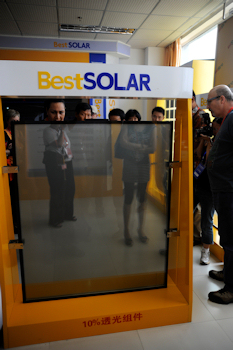 |
Best Solar Co.
Solar panel for thin film solar modules |
|
|
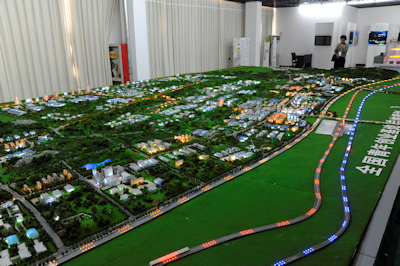 |
DigiEcoCity--model of a new Gongqing City |
|
Jiujiang City
The delegations visited a building where a small-scaled model of a new Gongqing City was on exhibit. DigiEcoCity, designed for a population of 100,000, is being built to address China’s rapid urbanization complexities. Based on ecological principles, DigiEcoCity was designed with innovations in housing, transportation, water, and infrastructure, emphasizing environmental and sustainable growth solutions. |
|
An afternoon visit to rural Zifang (Xingfang) Village (population 188 with 46 families) brought out many families, curious to see and meet the people from all over the world who had descended upon their village. The friendly and courteous people welcomed us warmly as we toured various homes, cultivated areas and other sites throughout the village. Designated as a Biogas Project, the De’an County village boasts two centralized bio-gas tanks and 20 individual tanks with bio-gas available in over three quarters of the households. Cotton is an important crop in the area. |
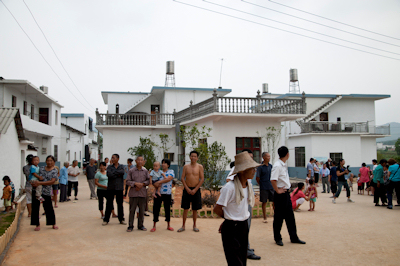 |
Rural Zifang (Xingfang) Village |
|
|
After leaving the farm village, the tour group came to the Tianmu Hot Springs Hotel, located in the beautiful and mountainous area of Xingzi County to spend the night. This was quite a lovely place to stay, where the mist in the mountains seemed to cover the alluring hills and the waters of the springs seemed so inviting. |
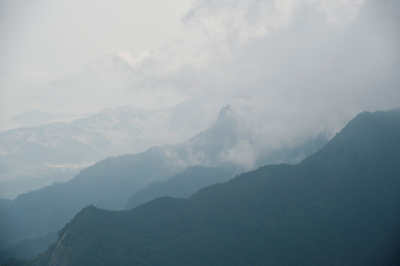 |
Hanpo mountain/valley with mist |
|
Mt. Lushan
Departing for Mt. Lushan, the entourage wound up the narrow, curvy roads, where often there was only room for one lane of traffic with views of sheer cliffs and no shoulder room at all. Situated between the Yangtze River and Poyang Lake, graceful Lushan Mountain is widely acclaimed for its extraordinary beauty and ancient historical sites. Many breathed a sigh of relief when all arrived safely at Xihu Hotel located on lovely Ruqin Lake. Excited travelers found walkways and hidden paths to follow all around the lake and the picturesque town close by was often enveloped in clouds and mist. |
|
Later that day the group visited Hanpokou (mouth that swallows the Poyang Lake) on scenic Hanpo Mountain. One could see tiny cable cars in two rows traversing the valley up to the mountain and sweeping breathtaking panoramic views of mountains, mist and valleys. It actually started to mist at Botanical Gardens, so some went ahead to view the flowers and some turned back. |
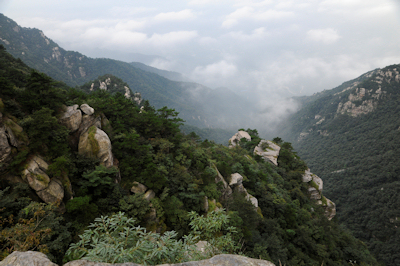 |
Mountain View of Mist from Brocade Path |
|
|
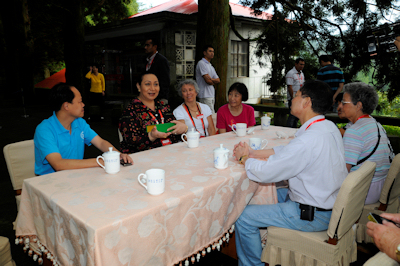 |
Friends invited to have tea with Ms. Pilolevu Tuiva, Princess of Tonga |
|
As we were returning, the Princess of Tonga invited us to have tea with her in the garden. Another lovely afternoon passed. |
|
There were only two days left to see Jiangxi Province. We followed the Flower Path where long ago blooming peach blossoms enticed poet Bai Juyi to write on his way to Dalin Temple:
All flowers have withered outside
But the peach flowers at the mountain temple have just begun to bloom
I’d felt sad that spring had gone.
I had not expected to meet it here. |
| |
| Climbing Brocade Path was so invigorating. Many were able to make the steep trek and were greeted by more fabulous panoramic views of dizzying heights versus extreme lows, rugged cliff features with tiny, fragile wildflowers. The treat was getting to see the Immortal’s Cave on the pathway and feeling like maybe here one could really become immortal as clouds float by mystically in the sky. The legend tells of Lu Dougbin living in that cave, becoming an immortal before he joined the seven others to cross the sea. |
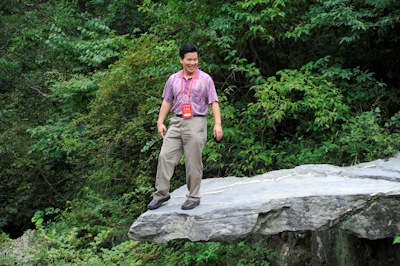 |
Mr. Xu Fenghua, Director of Department of American and Oceanian, CPAFFC Brocade Path, Lushan Mountain |
|
|
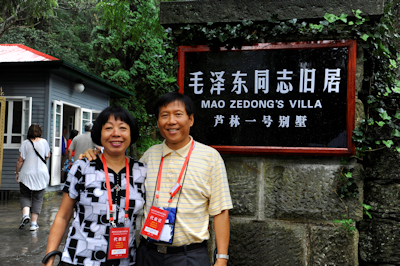 |
Ed and Suzanna Lin
Mao Zedong's Villa |
|
Lushan has many villas which were built by foreigners eager to see the financial advantages of the beautiful area. The Meilu Villa belonging to Chiang Kai-shek and Soong Mei-ling was also visited by Mao Zedong on his first stay in Lushan. Mt. Lushan is also known for the Lushan Conference in 1959 where Mao exerted his influence which empowered him to implement the Great Leap Forward. We visited the Lushan Museum which encompassed Mao’s sprawling house and exhibited much of the original period furniture. We were sightseeing at Mao’s villa when a thunderstorm surprised us. All of a sudden we saw festive, multi-colored umbrellas everywhere dotting the landscape. |
|
We visited the family summer home of Pearl Sydenstricker, later known to the world as Pearl Buck. The family escaped the sultry summer temperatures and enjoyed the coolness of the Lushan resort area. Having recently visited Pearl Buck’s birthplace in Hillsboro, West Virginia, it was coincidental to be here following her journey to China and then being in the place she lived as a child in the setting where her writing had its origins. |
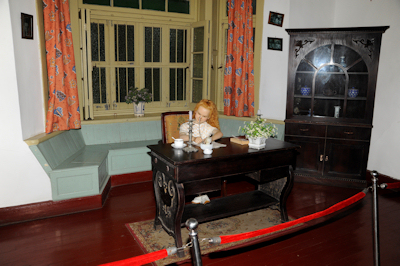 |
Wax replica of Pearl Sydenstricker as a child at Villa 310 Residence of the future Nobel Literature Prize Winner, Pearl Buck. |
|
|
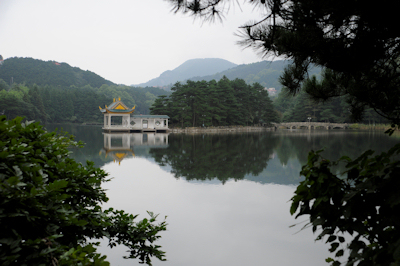 |
Ruqin Lake in Lushan Mountai |
|
Jingdezhen City
The group bade farewell to Mt. Lushan as we departed for Jingdezhen City and checked in to Zijing Hotel. Jingdezhen City is world-renowned for its long history of making porcelain. While on the grounds of the Museum of Porcelain History, tour members were able to see porcelain objects from different historical periods, architectures of Ming and Qing dynasties and hear music played on porcelain instruments. We saw first-hand a group of ancient kilns and walked inside one that is still fired once a year. Master potters and painters making practical and decorative porcelain creations were at work while we toured. On the last day of the tour, the delegations also visited the Porcelain Museum which housed many expensive and priceless works. The nearby ceramics market featured all kinds of porcelain objects in myriad colors, shapes and sizes from which to choose. Wanting to take more treasures home, each traveler wondered how they would meet the luggage weight requirements and still bring back another porcelain gift. |
The time came for us to fly out of Jingdezhen Airport on the eve of Thursday, September 16. Some went to Shanghai and Beijing; others continued on separate journeys. Many new friendships were started; many old friendships were renewed. One is silver and the other is gold.
Again, the USCPFA Delegation sincerely thanks the CPAFFC, CIFCA and Jiangxi Provincial People’s Government and all of those who made our stay in China such an amazing journey. The kindnesses shown to us will always be remembered.
Diana Greer, Tour Leader
Photographs by Linda Hanley |
| Copyright 2019 USCPFA |